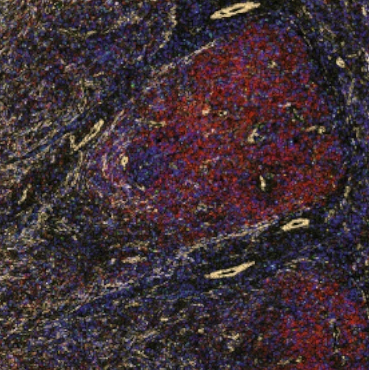
In T follicular helper cell lymphoma, a type of blood cancer, each cancer cell is highly heterogeneous even within the same patient, and the accumulation of genetic and chromosomal abnormalities accelerates the evolution of cancer cells. We revealed that cancer cells and surrounding immune cells cooperate to create an immune evasion environment that contributes to treatment resistance.
T follicular helper cell lymphoma (TFH lymphoma) is a subgroup of blood cancer, but no standard treatment has been established and the prognosis is often poor. One of the reasons why treatment is difficult is due to variation in cancer cells between and within patients (tumor cell heterogeneity), which means each cell responds differently to treatment and that cancer cells stubborn to treatment potentially survive and proliferate. Additionly, it is thought that in cancer tissue, the interaction between cancer cells and surrounding immune cells create an environment favorable for cancer cell survival (cancer-immune microenvironment), which is also believed to be a contributing factor to the acquisition of treatment resistance. However, these findings had not been fully elucidated in TFH lymphoma until now. This study clarified and comprehensively analyzes cancer cells and immune cells in TFH lymphoma using single-cell level gene expression/mutation analysis and spatial analysis technology and obtained an overall picture of the characteristics of cancer cells and the immune microenvironment.
Results show that cancer cells in TFH lymphoma exhibit much more pronounced tumor cell heterogeneity than previously thought, that the accumulation of genetic mutations and copy number mutations promotes clonal evolution of cancer cells, and that TFH lymphoma becomes an immune-evasive environment due to increased similarity and cell proliferation characteristics, and interactions between cancer cells and immune cells. This contributes to treatment resistance. Furthermore, we also identified PLS3 as a new marker molecule that is specifically expressed in TFH lymphoma.
The results of this research will lead to the development of new treatments that target the network between immune cells and cancer cells and is expected to be applied to therapeutic development strategies for rare cancers other than TFH lymphoma. (Translated from University of Tsukuba Website - Press Release)
血液がんの一つであるT濾胞ヘルパー細胞リンパ腫では、同じ患者内でもがん細胞一つひとつは非常に不均一であり、遺伝子・染色体異常の蓄積によりがん細胞の進化が促進されること、がん細胞と周囲の免疫細胞が協調して免疫回避環境を作ることで治療抵抗性に寄与していることを明らかにしました。

T濾胞ヘルパー細胞リンパ腫(TFHリンパ腫)は血液がんの一亜群ですが、標準的な治療が確立されておらず、予後は不良です。治療が困難な原因の一つとして、患者間・内のがん細胞のばらつき(腫瘍細胞不均一性)により、細胞ごとに治療への反応性が異なり、治療が効きにくいがん細胞が生き残り増殖することが考えられています。また、がん組織において、がん細胞と周囲の免疫細胞が相互作用し、がん細胞の生存に有利な環境(がん―免疫微小環境)を作り出すことも、治療抵抗性を獲得する一因と考えられます。しかし、TFHリンパ腫において、これらの解明は不十分でした。本研究では、単一細胞レベルの遺伝子発現・変異解析および空間解析技術を用いて、TFHリンパ腫のがん細胞と免疫細胞を包括的に分析し、がん細胞の特徴と免疫微小環境の全体像を解明しました。
その結果、TFHリンパ腫のがん細胞が、これまで考えられていたよりずっと顕著な腫瘍細胞不均一性を示すこと、遺伝子変異やコピー数変異の蓄積によりがん細胞のクローン進化が促進され、TFH細胞類似性や細胞増殖形質が高まること、がん細胞と免疫細胞の相互作用により免疫回避型環境が形成され、治療抵抗性獲得に寄与することが明らかになりました。さらに、TFHリンパ腫に特異的に発現する新たなマーカー分子として、PLS3を同定しました。
本研究結果は、免疫細胞やがん細胞とのネットワークを標的とした新たな治療法の開発へつながるとともに、TFHリンパ腫以外の希少がんにおける治療開発戦略への応用が期待されます。( → プレスリリース 筑波大学ウェブページ)


